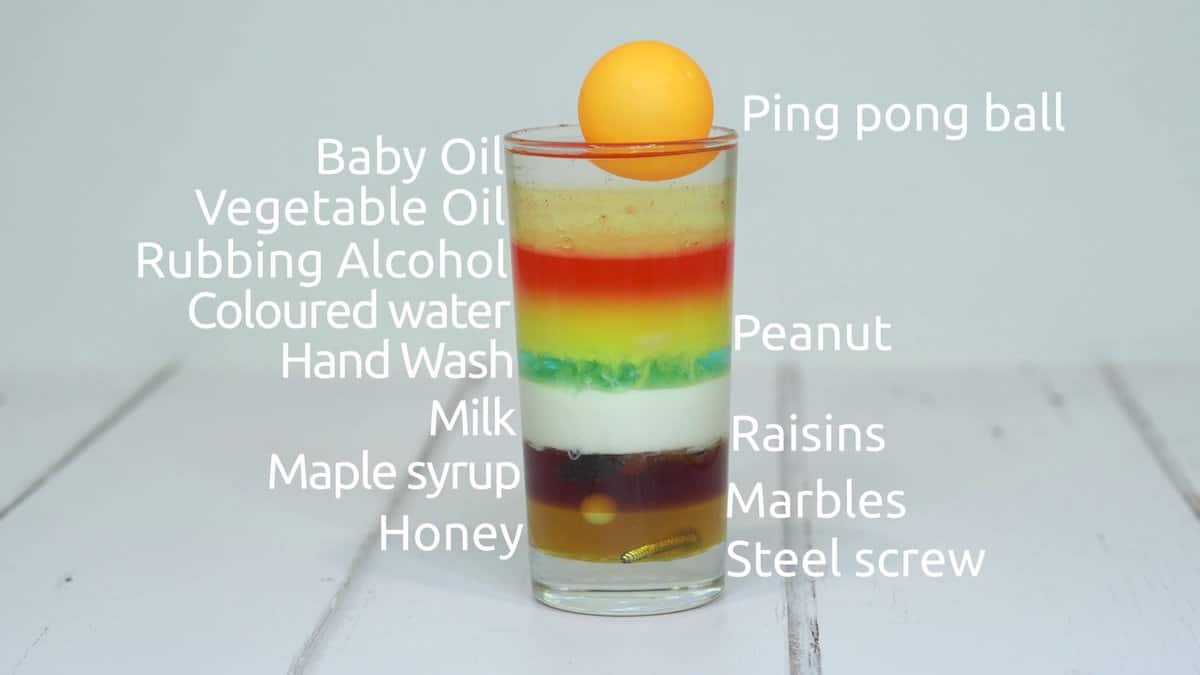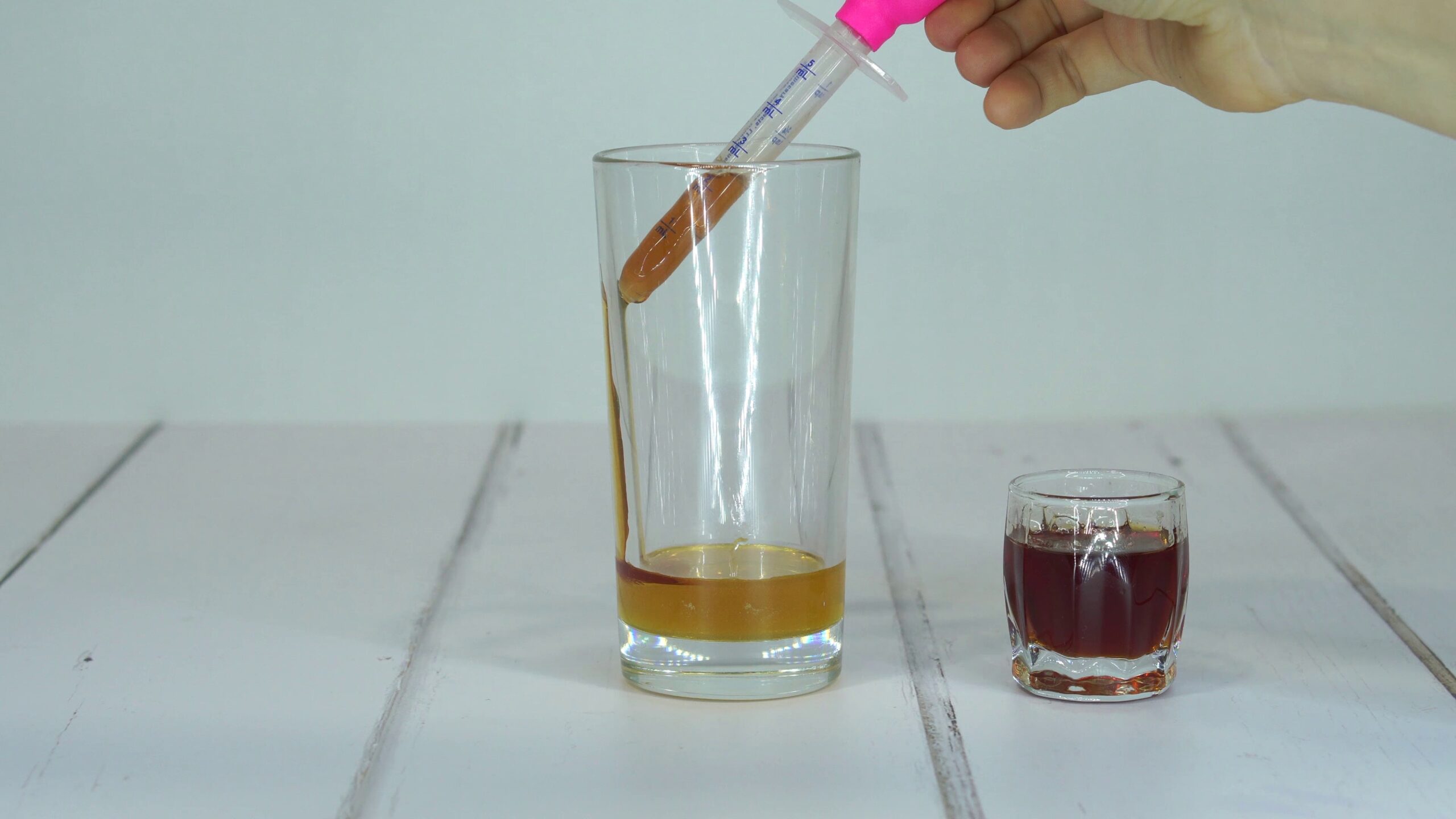-
9-10 , 12+
-
5 to 20 min
-
Normal

This density column experiment looks great and also teaches us about two important concepts in chemistry and physics – density and buoyancy! Max and Alex were wowed by the finished product and spent a good time while collecting lots of extra household items to drop into the tower. We had a productive chat about fluid density afterwards, which allowed me to introduce the concept of a materials mass.
List of Materials
If you don’t have one of the liquids listed, just leave it out – the experiment will work just fine without it. Don’t replace it with another liquid – chances are it will have a different density, which will ruin the look of the final product! That being said, once you’ve set up a successful density tower, going off-book and trying out different household liquids can be a fun activity in itself.
Step by Step Instructions
Prepare all of the liquids in separate beakers, cups or glasses.

Start by pouring the honey into the tall glass.

Add the next layer of the column (maple syrup) carefully, either using a syringe or a very steady hand!

Repeat this process until you have filled the tall glass with each of the eight liquids. Sit back and marvel at your weird and wonderful looking density column!

Starting with the steel screw, drop each of the small objects into the density column. Take note of where each one stops sinking!

Video Tutorial for 8-Layer Density Column
If you liked our 8 layer density column experiment, you may like Rainbow Density Tower.
The Science Explained
This experiment is great for introducing the concepts of density and buoyancy, and how they relate to each other.
The density of a substance or material is its mass per unit of volume. Let’s picture 100ml of two different liquids of differing density. If we were to weigh each of the 100ml volumes, the dense liquid would weigh more than the less dense liquid.
But how does the density tower work? The liquids used in this experiment have already been ranked from the most dense (honey) to the least dense (baby oil). If two liquids of different densities are mixed, the more dense one will sink to the bottom and the less dense one will float on top. This is demonstrated in our density column – but with eight different liquids rather than two! Some mixing will take place at the boundaries between the different liquids but in general, they are happy to stay separate.
When we add the different objects to the glass/vase, we see the effects of buoyancy. The heaviest object – the screw – sinks straight to the bottom. But as you may have noticed, the other objects stop part of the way down – floating at a boundary between two liquids.
The density of a liquid is a very important part of what decides whether or not an object will float in it. The weight of the object is another very important variable. Combined, these variables control the force of buoyancy – which is what makes something float!
We see both of the variables mentioned in action here. In terms of the object, it matters less what it is made of but how much it weighs (and how much air is inside it) The screw weighs more than the raisin or the marble, so it overcomes the forces of buoyancy exerted by all the liquids and sinks to the very bottom. The marble might weigh less than the screw, and the force of buoyancy keeps it afloat on top of the honey layer. The ping pong ball doesn’t sink at all – it simply sits on top.

Going Deeper Into The Science
Let’s think a little more about fluid density.
Density is calculated by working out the mass per unit volume of a substance. In this scenario, mass is taken as how much an object weighs (e.g. in kilograms or grams), although it is not strictly true that ‘mass’ simply means the same as ‘weight’.
(A physicist might say that mass is a constant property of an object, but its weight depends on the force of gravity (or specific gravity) where it is being measured. To illustrate this point, an object would have the same mass on both earth and on the moon, but due to vastly different gravitation forces, the object would weigh far less on the moon than it would on earth.)
The volume of an object is defined by how much space it occupies, measured in cubic units (e.g. cm3, m3).
The density of a liquid or gas is not constant and can vary if certain environmental factors are changed. For instance, the volume of a liquid or gas will increase as it is heated. This is due to molecules having more kinetic energy with higher temperatures, leading to them move about and crash into each other more often. Because of this, the same number of molecules will take up more space at a higher temperature than at a lower one. A solid will not change in volume when heated, as its molecules are locked into a lattice and can’t move around.
The density of water is commonly given as 1 g/cm3. This is a generalization – the density of water will vary with temperature. The density of water at room temperature (25° C) is 0.9970 g/cm3. At 95° C, the density of water is 0.9619 g/cm3.
For comparison, let’s consider the density of some heavy liquids. The toxic metal mercury is the densest liquid known to man. It’s also the only metal that is liquid at room temperature. The density of mercury is 13524 g/cm3 at 25° C! That means












